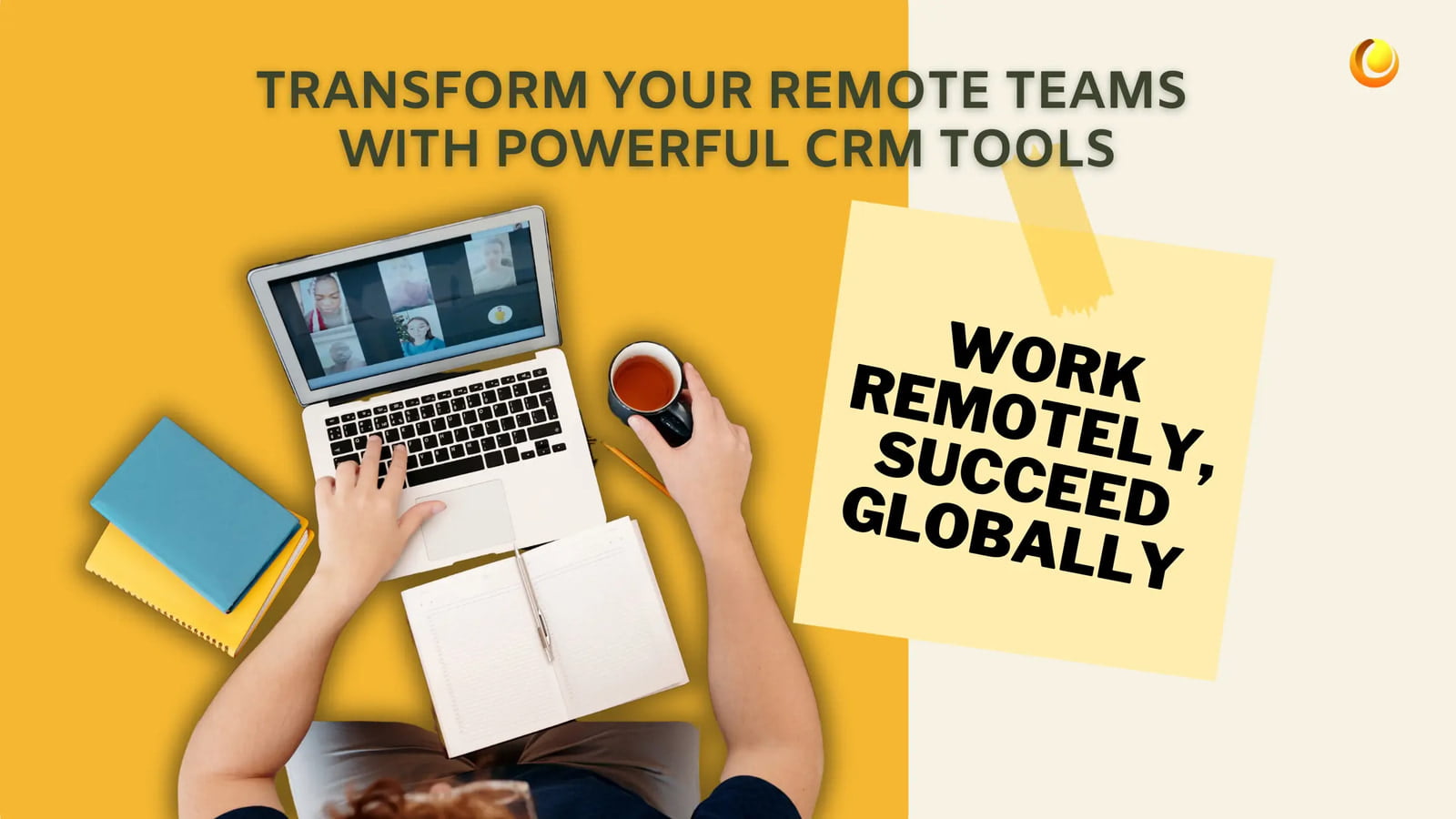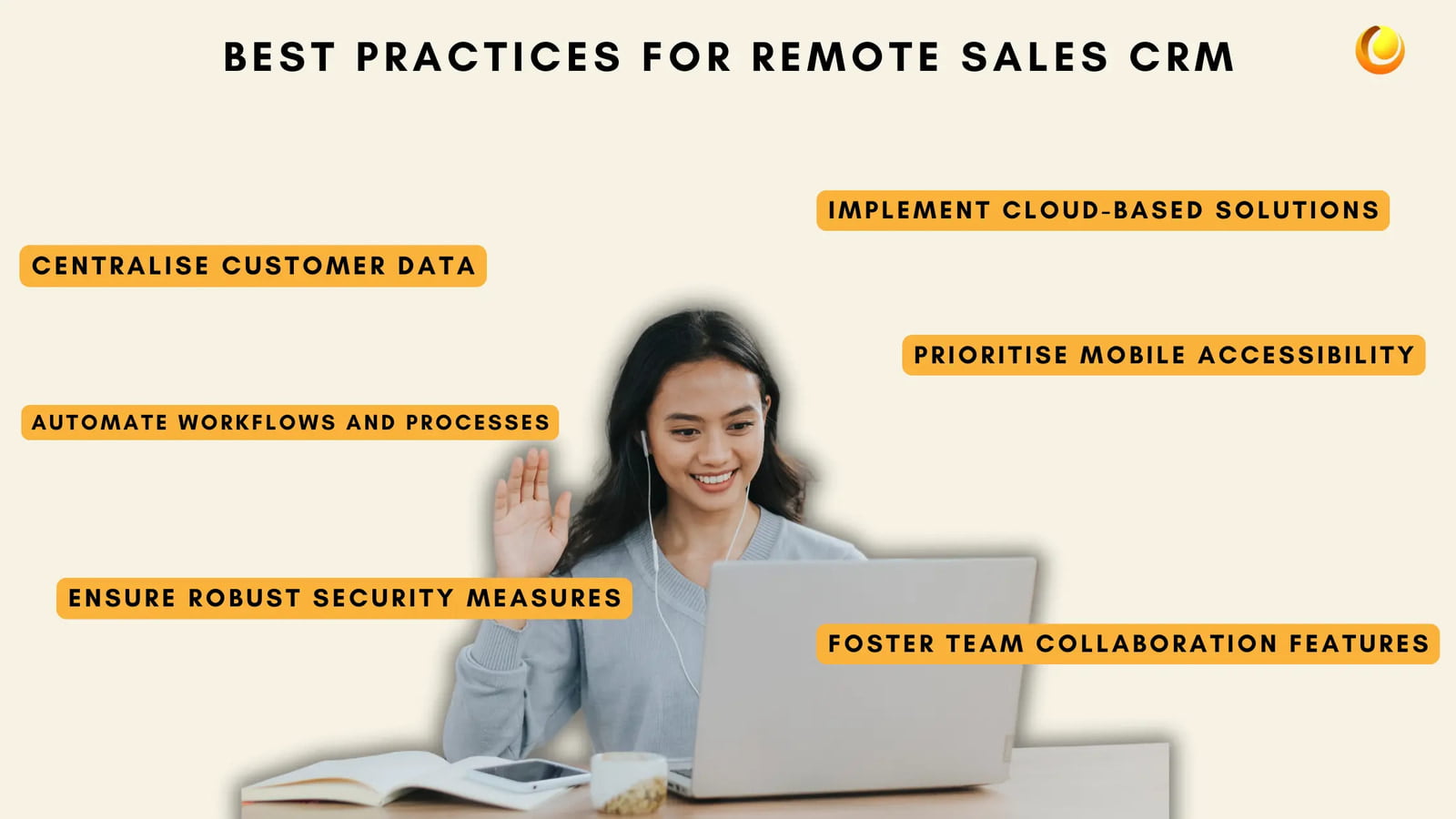The sales landscape has changed a lot over the last couple of years. We will talk about the world of Sales CRM for remote teams: best practices, key features, and top tools in the market. We're going to talk about the problems remote sales teams face and give effective solutions that will help in resolving them. Whether you are a sales manager working on how to maximise the output of your team or a sales professional adapting to switching to remote work, this guide will equip you with what you should know to utilise CRM effectively in a dispersed environment.

List of Content
- Introduction
- Challenges of Remote Sales Teams
- Best Practices for Remote Sales CRM
- Essential CRM Features for Remote Teams
- Top CRM Tools for Remote Sales Teams
- Implementing CRM for Remote Teams
- Measuring Success and ROI.
- Advanced Strategies for Remote Sales CRM Success.
- Overcoming Common Challenges in Remote Sales CRM Adoption.
- Conclusion
Introduction
Remote work has changed the way sales teams used to work. No longer does a salesperson necessarily stay within the premises of their office; people collaborate increasingly across cities, countries, or even continents. This transition brings both opportunities and challenges connected with customer interactions and sales processes in particular.
A well-optimised CRM is so much more than a tool for remote sales teams—it is their lifeline to keep the staff connected, centralise critical data, and drive forward sales tactics. The value of CRM for distributed teams simply cannot be overemphasised. It functions virtually as a headquarters, offering assurance that everything and everyone has equal access to information from wherever they may be.
Challenges of Remote Sales Teams
While remote work offers flexibility and access to a larger base of talent, remote work also unleashes new challenges for sales teams. The ability to understand these barriers is very critical to developing successful CRM tactics.
Communication Barriers
- Lack of face-to-face interactions: Working from home eliminates casual conversations and non-verbal behaviours, which are frequently used to generate ideas or solve problems quickly. If they are not present, misinterpretations and missed collaboration changes may occur.
- Different Time Zones: This makes it hard to schedule meetings and even respond quickly, which in turn affects decision-making and consumer interactions.
Collaboration Difficulties
- Coordinating team efforts: Without a common tangible area, it is hard to develop a feeling of being a cohesive team. If people are working in a distant location, it requires some amount of conscious effort from all members to be on the same page concerning goals, tactics, and current priorities.
- Sharing information effectively: The casual interchange of information that happens in an office setting is lost in its entirety. To be at par, remote teams will have to work out a way of sharing customer insights market trends and best practices effectively.
Data Accessibility and Security
- Providing secure access from multiple locations: Under this, the private data of the clients is accessed from numerous places or devices. As a result, there are associated risks that the data might be jeopardised by an unwanted breach.
- Maintaining data integrity: When several team members access and control data remotely, guaranteeing consistency and correctness becomes increasingly difficult. Duplicate entries, out-of-date information, and data gaps can jeopardise the CRM system's trustworthiness.
Best Practices for Remote Sales CRM

These best practices in CRM usage were put into action to deal with such challenges and to make the most out of a remote sales team. Here are important strategies to optimise your CRM for working remotely:
Centralise Customer Data
- Establish a single source of truth: Set up your CRM as the hub of all customer truth. This includes the actual contact details, detailed history of interaction with them, sales pipeline statuses, and anything else relevant to your business. With one source of truth, you eliminate misconception, confusion, and errors. Plus, it also ensures that the latest information is in use by your team members.
- Standardised data within the team: You should specify the data and how they are processed within it. Field, category, and procedure standardisation will ensure uniformity. Regular audits and cleaning sessions of your CRM database will make everything work like clockwork.
Implement Cloud-Based Solutions
- Cloud CRM is Great for Remote Teams: Cloud-based CRM gives some awesome advantages for remote personnel. With real-time updates and seamless collaboration, access from anywhere, at any time, and on any device with an internet connection provides great flexibility needed by any touring salesperson who has to update and access the information of a customer on the go.
- Scalability and Flexibility: Cloud CRMs can be quickly scaled to accommodate your team's expansion. Many of them have modular structures that allow you to easily toggle components on and off based on your changing demands. This flexibility benefits remote teams that may abruptly expand contracts or otherwise change in composition.
Prioritise Mobile Accessibility
Anywhere access is a critical aspect: More often than not, remote sales teams are geographically dispersed, with one of the workstations being a home office. With mobile CRM, the salespeople can update records, check customer information, and log activities instantaneously immediately after the call or meeting has taken place.
Key features of mobile CRM apps include the following:
- Intuitive user display and compact operator interface.
- Offline mode: when the internet is not available.
- Get push notifications for critical updates or tasks.
- Integrating Mobile Devices Functions: You can integrate click-to-call with location-based analytics via GPS.
Automate Workflows and Processes
Automate tasks that repeat themselves: There is a need to examine selling processes to see where operations can be automated. This may well be around lead assignments, follow-up reminders, or even data entry from email communications.
Some examples of effective sales automation are:
Automated email lead nurturing sequences.
Creating tasks on the change of deal stage.
Automated lead scoring and prioritisation.
Generated and distributed reports.
Automation is not just a time-saving function but also one that will ensure consistency in all processes among your remote team—not letting a task drop through the cracks.
Foster Team Collaboration Features
- Internal communication tools: Look for CRM systems with inherent chat, comment, or note-sharing capabilities that permit staff to communicate about accounts, share insights, and ask questions without having to leave the CRM environment.
- Shared calendars and task lists: Implement features that allow team members to view each other's schedules, assign tasks, and track progress on shared projects. It helps your remote teams stay accountable to the task at hand, allowing management to make smarter decisions and allocate resources.
Ensure Robust Security Measures
- Data encryption and protection: Do your study and select a CRM that provides end-to-end data encryption at rest and in transit. It becomes considerably more relevant when you access the system over multiple networks.
- User Authentication and Access Control: You should have multi-factor authentication in place. Enforce role-based access controls to provide each of the team members with the least possible data to reduce the impact in case of unauthorised disclosure.
These strategies can help your remote teams to overcome many of the problems of dispersed work environments. A properly implemented CRM is much more than a database; it provides a superb environment for business success collaboration that is not limited by physical location.
Essential CRM Features for Remote Teams
There are certain factors, of course, that take on more importance when a CRM for remote sales teams is considered. These skills ensure that operations run smoothly, collaboration works fine, and productivity is optimum in a remote setting.
Real-time Data Synchronisation
- Updated Information: Everything goes with current and updated information in remote work. Real-time synchronisation takes care to ensure that everyone on the team is up to date with the most recent data, thus preventing disputes and redundancies.
- Cross-device and cross-user syncing: An ideal CRM should allow you to easily exchange and access data across different systems, including desktop apps, mobile applications, and users. It also allows your staff to use any device at any time without missing any updates, opportunities, or lost work.
Task Management and Reminders
- Task assignment and tracking: A task management system integrated with CRM will help the teams to keep themselves organised and accountable. It needs to create, assign, and track tasks against particular deals or clients.
- Automated Reminders: These automated follow-up reminders about deadlines and other key events will be necessary for staying on course. They can further be customised based on personal choice and time zone.
Integration with Communication Tools
- Email integration: It synchronises emails with CRM, automatically logging communications and directly sending emails from the CRM interface to improve workflow and guarantee documentation for all contacts with customers.
- Video conferencing and chat platforms: It integrates technologies like Zoom, Microsoft Teams, or Slack, allowing seamless communication without moving from one program to another.
Analytics and Reporting Capabilities
- Sales forecasting: Advanced analytics tools that provide accurate sales forecasts based on historical data and current pipeline help remote teams set realistic goals and make informed decisions.
- Performance tracking: Customisable dashboards with a view into performance metrics by individual and team level are especially needed by the remote manager, to keep tabs on progress and try to find areas for improvement.
Customisable Dashboards
- Creating role-specific views: The ability to customise dashboards based on roles (e.g., sales rep, manager, executive) ensures that each team member sees the most relevant information for their responsibilities.
- Key Metric Visualisation: Interactive charts & graphs keep every eye on the dashboard for progress regarding KPIs at one glance. It helps your remote teams understand and thus focus on areas of high priority.
Top CRM Tools for Remote Sales Teams

There is quite a large election of CRM solutions which can be considered useful for a field sales team; here are five of the top ones:
Salesforce
Key Features
Numerous customising options
Powerful mobile app with offline functionality
AI-powered insights with Einstein Analytics
A variety of third-party connectors.
Pros and Cons
Pros: high scalability for expanding teams, a comprehensive feature set, and robust security measures.
Cons: Complex setup and management and expensive compared to other options.
Zoho CRM
Key features
AI-powered sales assistant (Zia)
Gamification features to motivate remote teams
Multi-channel communication tools
Customisable modules and fields
Pros and Cons
Pros: Competitive pricing, integration with other important corporate tools, and advanced automation features.
Cons: User interface may be less intuitive than competitors. Some functions require additional Zoho products.
HubSpot CRM
Key Features
User-friendly interface.
A free basic plan with key features.
Integrated marketing and customer service tools.
Integrated video calls, or even the scheduling of meetings.
Pros and Cons
Pros: ease of use, a generous free tier, and seamless connection with other HubSpot tools.
Cons: Advanced features are limited to higher-tier plans. Adding more features and contacts can increase costs.
Pipedrive
Key features
Intuitive, visual sales pipeline
AI-powered sales assistant
Customisable dashboards and reports
Strong mobile app for on-the-go access
Pros and Cons
Pros: simplicity and ease of use, very affordable pricing for small to medium-sized teams, and excellent pipeline visualisation.
Cons: The marketing automation features are not that many, with limited sophisticated customisation choices.
Microsoft Dynamics 365
Key Features
Deep integration with the Microsoft 365 suite.
AI-driven insights and recommendations for the best next steps
Strong security and compliance features.
Mixed reality features for remote product demonstrations
Pros and Cons
Pros: Easy interaction with Microsoft tools, advanced AI and analytics capabilities. and a highly scalable for enterprise-level enterprises.
Cons: Complexity in implementation and customisation and expensive for a complete feature set.
Implementing CRM for Remote Teams
Implementing a CRM system for a remote sales team requires careful planning and execution. The steps below mention some of the essential activities involved in having a smooth transition:
Choosing the Right Solution
- Assessing team needs: First and foremost, make a detailed analysis of what your team really needs. Some things to consider are team size, the complexity of your sales process, the type and number of integrations needed, and budgetary constraints.
- Scalability Consideration and Cost Estimation: Consider not only the short-term requirement but also the long-term one. If this were to be scaled, work out the total cost of ownership, including the hidden costs associated with its implementation, training, or onboarding of new users or features.
Training and Onboarding
- Create a complete training program: Create a comprehensive training strategy that addresses both CRM functionality and remote work best practices. Consider accommodating different learning styles by providing a combination of live webinars, recorded courses, and written materials.
- Ongoing assistance and resources: Create a knowledge base to address typical queries and difficulties. Appoint CRM experts in your team or work with CRM consultants to provide peer assistance and gather feedback for ongoing improvement.
Establishing Best Practices and Protocols
- Creating a CRM Usage Guide: Be explicit about data entry, pipeline management & communication requirements in the CRM. Focus on creating uniformity within your remote team, and the integrity of the data must be preserved.
- Establishing expectations for data entry and management: Communicate how important it is to keep the CRM up to date. Consider using data quality scores or gamification features to encourage consistent and accurate data entry.
Following these deployment tactics allows remote sales teams to harness the benefits of their selected CRM solution, resulting in greater collaboration, productivity, and, ultimately, sales success.
Measuring Success and ROI
You had invested a serious amount in the CRM for the remote sales team, and you would naturally want to keep tabs on its success. The below steps would judge whether your CRM implementation was a success or not.
Key Performance Indicators (KPIs)
Sales metrics
Conversion rates across all levels of the sales funnel.
The average transaction size & the duration of the sales cycle
Winning rates and income increase
Customer Acquisition Cost - Customer Lifetime Value.
Team Productivity Metrics
Representative activities in the team
Administrative vs. sales time analysis
Velocity of Pipeline
CRM adoption rate & consistency
Regular Reviews and Adjustments
- Schedule performance reviews: Set up reviews timely to analyse & compare CRM performance against set KPIs. This allows for trend identification and the ability for data-driven decisions.
- Collecting team comments and implementing improvements: Regularly solicit feedback on your remote team's CRM experience. Use this feedback to improve processes, seek new functionality from your CRM supplier, or change your implementation plan.
Advanced Strategies for Remote Sales CRM Success

Once your team has grasped the fundamentals of the CRM system, you may consider using these advanced tactics to improve team performance:
Leveraging AI and Machine Learning: You can leverage AI capabilities in sales predictions and trends, transaction hazards, and optimal times for communications with your clients. AI chatbots will help automate regular client enquiries, freeing time for more meaningful engagements by your remote employees.
Integrating Social Selling Tools: Integrate social listening technologies with your CRM, and the capability it gives in tracking brand mentions, competitors, and market trends will be added. Your team can use CRM to capture quality leads from social media interactions; and auto-create or -update contact data.
Implement gamification: leaderboards, badges, and point systems. Drive some competition and incentives within your CRM. Get your remote teams motivated by a little friendly competition. Engage and reward the top performers, based on CRM data, to foster a healthy work culture for your remote workers.
Overcoming Some Common Challenges in Remote Sales CRM Adoption
Even with the best of planning, some problems will crop up in the implementation of a CRM for remote teams. Here's how to overcome some common problems:
Resistance to Change: Be open about the reasons, why you should want to implement or upgrade CRM systems. Address individual problems via open communication channels. Showcase early successes and how the CRM simplifies their jobs. Use concrete examples to demonstrate how the system enhances their daily operations.
Data Quality Issues: You have to introduce data validation rules within your CRM, like Creating automated checks for the consistency and completeness of the data. You should include fields that are required, format checking, or detection of duplicates. Do Regular data cleaning, schedule periodic data & provide proper maintenance. Consider implementing data enrichment services to ensure that information is up-to-date and accurate.
Technology Barriers: Provide guidelines or stipends for remote employees to have reliable Internet connections. Consider a CRM that is strong in its offline capabilities, especially in regions with poor or patchy connectivity. Implement explicit policies related to device requirements, including provisions for both corporate-supplied and personal devices used in work.
Conclusion
The only thing that has changed in the sales world is that businesses need CRM. From adopting cloud solutions to shifting focus to mobile access, next-generation technologies such as AI and automation can help remote sales teams break the shackles of distributed work.
Remember that implementing a CRM is a process, not an event. Keep collecting the input and measure its effectiveness, all while continuing to make changes that will help your CRM remain relevant and a helpful tool for your remote sales force.
In the future, the role of CRM in remote sales will become even more important. Looking ahead, staying ahead means continuing to reassess and refine your approach to set your team up for long-term success in the shifting landscape of remote sales.
IT Solutions Solved is the experienced CRM consultancy based in Australia. Want to implement CRM for remote work. You can connect with us by clicking the button below.
Thanks for your valuable time. Have a nice day!





